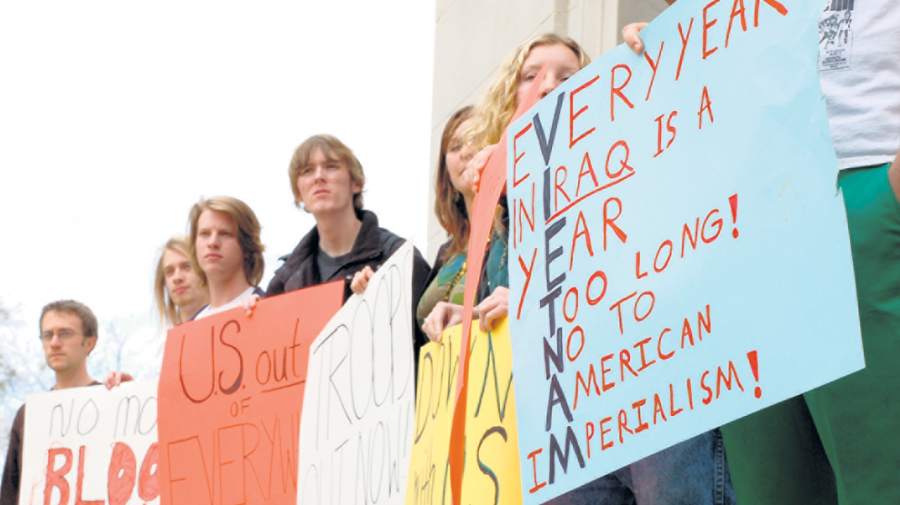Bottles of Budweiser resting on a table, a couple laughing on the Quad, a boy with long hair playing the guitar and an occasional peace sign fill the pages of the Corolla in 1969 and 1970.
But everything was not happy and carefree during the era of hippies and the Bear. The Civil Rights Movement, the Vietnam War and the women’s movement were a constant background presence throughout this time period.
Headlines from The Crimson White, like “SGA ‘Stinks’ But…People are Groovy,” “Campus Sexually Segregated,” “Whither Vietnam?” and an entire front page dedicated to ‘PEACE ON EARTH’ scream of tightening cultural tensions on campus.
And then came the student protests.
“The protests started small in the spring of 1967,” said David Lowe, the computer services librarian at the University’s Law School and a UA student during the Vietnam War. “There were only about three pickets. A couple of years later people began sitting on the steps of the Union Building, which is now Reese Phifer.”
Lowe said protests for women’s rights occurred as frequently as the war protests.
“The women’s movement at UA was progressing much slower than in other parts of the country,” he said. “Women were not allowed to wear shorts to class and were given strict curfews at night.”
Jim Ziegler, a candidate who ran for president of the Student Government Association in 1969, said he considered women’s rights a major platform in his campaign.
While every college in the nation was affected by the political upheaval, the protests weren’t as bad at the University because the administration was easily accessible and willing to listen to students, said Tom Land, institutional records analyst with the University archives.
“Because Dr. David Mathews was 33 when he became the president, he was more open to students,” Land said. “The administration always listened to the protestors, even if they did not end up doing what the students wanted.”
Land said closing the generation gap helped dispel some of the more violent protests other campuses were dealing with.
Approximately 300 protestors would show up for a demonstration, Lowe said. However, it was always the same 300 people, and that number did not really increase until after the Kent State shootings.
“The National Guard fired at point blank range into a crowd of protesting students at Kent State in Ohio,” Lowe recalled. “They killed four and injured several others. In response to that, there were demonstrations all over the country at every university.”
Lowe said a women’s liberation group planned a candlelight vigil in front of one of the ROTC buildings at the University on May 6, 1970.
“I was there, and that was all that was planned,” Lowe said. “Stoney Jackson gave a spontaneous speech, and then the crowd went across the quadrangle and gathered in front of the President’s Mansion. This was early evening, probably around 7 or 8 p.m.”
Lowe said he thought the event was over, but he later discovered that the students occupied the Union Building and snack bar. The same night, a wooden gymnasium, located where the Ferguson Center now stands, was burned to the ground.
The gymnasium had not been in use for several years, Lowe said, and it was gutted and prepared for destruction in June. While no one was convicted for arson, many people believed students had burned the building.
However, Lowe said that an FBI informant admitted on a public television program that he had set the fire.
“It was a former UA student, Charles Grimm, who had been in trouble for drugs and was looking at a long prison sentence,” Lowe said. “He worked for the FBI in exchange for those charges being dropped.”
Exchanges like Grimm’s with the FBI were a part of a common counter intelligence program at that time, Lowe said.
“The FBI had a series of tricks to undermine the civil rights and women’s movement,” Lowe said. “This was one of a series of experiences that made me very cynical. People in authority positions were not telling me the truth.”
Lowe said a day or two after Grimm burned the gymnasium, several Tuscaloosa policemen violently broke up a small protest on University Boulevard in front of the union building.
“The policemen wore strips of tape covering their badges and did not discriminate between protestors and passersby,” Lowe said. “They beat up the DKE president and his girlfriend in the DKE front yard, and when I say beat up, I don’t mean giving them a black eye. They used clubs.”
After this incident, Lowe said the entire campus was alienated from the police and administration.
“Everyone knew someone who had been beaten up,” Lowe said. “Eventually they cancelled finals and closed the University for the summer.”
The students produced a list of demands, Lowe said, and they were successful in doing away with special restrictions on women.









